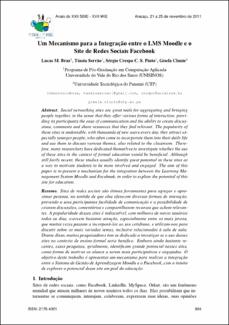El sistema se apagará debido a tareas habituales de mantenimiento. Por favor, guarde su trabajo y desconéctese.
Um Mecanismo para a Integração entre o LMS Moodle e o Site de Redes Sociais Facebook
| dc.contributor.author | Braz, Lucas M. | |
| dc.contributor.author | Serrão, Tássia | |
| dc.contributor.author | Crespo, Sérgio | |
| dc.contributor.author | de Clunie, Gisela T. | |
| dc.date.accessioned | 2018-04-03T21:09:29Z | |
| dc.date.accessioned | 2018-04-03T21:09:29Z | |
| dc.date.available | 2018-04-03T21:09:29Z | |
| dc.date.available | 2018-04-03T21:09:29Z | |
| dc.date.issued | 11/25/2011 | |
| dc.date.issued | 11/25/2011 | |
| dc.identifier.issn | 2176-4301 | |
| dc.identifier.uri | http://ridda2.utp.ac.pa/handle/123456789/4452 | |
| dc.identifier.uri | http://ridda2.utp.ac.pa/handle/123456789/4452 | |
| dc.description | Social networking sites are great tools for aggregating and bringing people together, in the sense that they offer various forms of interaction, provi-ding its participants the ease of communication and the ability to create discus-sions, comments and share resources that they find relevant. The popularity of these sites is undeniable, with thousands of new users every day, they attract es- pecially younger people, who often come to incorporate them into their daily lifeand use them to discuss various themes, also related to the classroom. There- fore, many researchers have dedicated themselves to investigate whether the useof these sites in the context of formal education would be beneficial. Althoughstill fairly recent, these studies usually identify great potential in these sites asa way to motivate students to be more involved and engaged. The aim of this paper is to present a mechanism for the integration between the Learning Ma-nagement System Moodle and Facebook, in order to explore the potential of thissite for education | en_US |
| dc.description.abstract | Social networking sites are great tools for aggregating and bringing people together, in the sense that they offer various forms of interaction, provi-ding its participants the ease of communication and the ability to create discus-sions, comments and share resources that they find relevant. The popularity of these sites is undeniable, with thousands of new users every day, they attract es- pecially younger people, who often come to incorporate them into their daily lifeand use them to discuss various themes, also related to the classroom. There- fore, many researchers have dedicated themselves to investigate whether the useof these sites in the context of formal education would be beneficial. Althoughstill fairly recent, these studies usually identify great potential in these sites asa way to motivate students to be more involved and engaged. The aim of this paper is to present a mechanism for the integration between the Learning Ma-nagement System Moodle and Facebook, in order to explore the potential of thissite for education | en_US |
| dc.format | application/pdf | |
| dc.language | eng | |
| dc.language.iso | eng | en_US |
| dc.rights | https://creativecommons.org/licenses/by-nc-sa/4.0/ | |
| dc.rights | info:eu-repo/semantics/openAccess | |
| dc.subject | Integração | en_US |
| dc.subject | LMS Moodle | en_US |
| dc.subject | Redes Sociais | en_US |
| dc.subject | en_US | |
| dc.subject | Integração | |
| dc.subject | LMS Moodle | |
| dc.subject | Redes Sociais | |
| dc.subject | ||
| dc.title | Um Mecanismo para a Integração entre o LMS Moodle e o Site de Redes Sociais Facebook | en_US |
| dc.type | info:eu-repo/semantics/article | |
| dc.type | info:eu-repo/semantics/publishedVersion |
